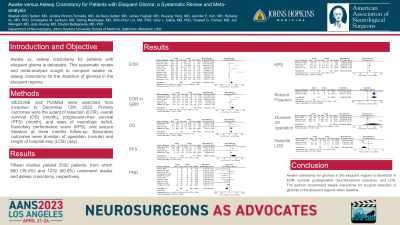Awake versus Sleep Surgery for Patients with Eloquent Glioma: a Systematic Review and Meta-analysis
Awake versus Sleep Surgery for Patients with Eloquent Glioma: A Systematic Review and Meta-analysis
Friday, April 21, 2023


Shahab Aldin Sattari, MD (he/him/his)
Post-Doctoral Research Fellow
Johns Hopkins University School of Medicine
ePoster Presenter(s)
Introduction: Awake versus asleep surgical resection for patients with eloquent glioma is still debated. This systematic review and meta-analysis sought to reach a consensus in this regard.
Methods: Medline and PubMed were searched from inception to August 8th, 2022. Primary outcomes were extent of resection (EOR), overall survival (OS) (month), progression-free survival (PFS) (month), persistent new neurologic deficit (PND), Karnofsky Performance Score (KPS) at three months post-operation, and seizure freedom at three months post-operation. Secondary outcomes were duration of operation (minute) and length of hospital stay (LOS) (day).
Results: 14 studies yielding 1959 patients were included, of which 764 (39%) and 1195 (61%) underwent awake and asleep resection, respectively. The meta-analysis concluded that in the awake group, the EOR (mean difference [MD]=7.36[3.23, 11.49], p=0.0005), OS (MD=2.89 months [1.37, 4.40], p=0.0002), PFS (MD=6.39 months [1.19, 11.59], p=0.02), KPS (MD=13.59[11.08, 16.09], p< 0.00001), seizure freedom (odds ratio [OR]=8.72[3.39, 22.39], p< 0.00001) were greater. Furthermore, in the awake group, the PND (OR=0.47[0.28, 0.78], p=0.004) and LOS (MD=-2.99 days [-5.09, -0.88], p=0.005) were lower, while the duration of operation were similar between the groups (MD=37.88 minutes [-34.09, 109.86], p=0.30).
Conclusion : We recommend awake intraoperative motor mapping for surgical resection of eloquent glioma.
Methods: Medline and PubMed were searched from inception to August 8th, 2022. Primary outcomes were extent of resection (EOR), overall survival (OS) (month), progression-free survival (PFS) (month), persistent new neurologic deficit (PND), Karnofsky Performance Score (KPS) at three months post-operation, and seizure freedom at three months post-operation. Secondary outcomes were duration of operation (minute) and length of hospital stay (LOS) (day).
Results: 14 studies yielding 1959 patients were included, of which 764 (39%) and 1195 (61%) underwent awake and asleep resection, respectively. The meta-analysis concluded that in the awake group, the EOR (mean difference [MD]=7.36[3.23, 11.49], p=0.0005), OS (MD=2.89 months [1.37, 4.40], p=0.0002), PFS (MD=6.39 months [1.19, 11.59], p=0.02), KPS (MD=13.59[11.08, 16.09], p< 0.00001), seizure freedom (odds ratio [OR]=8.72[3.39, 22.39], p< 0.00001) were greater. Furthermore, in the awake group, the PND (OR=0.47[0.28, 0.78], p=0.004) and LOS (MD=-2.99 days [-5.09, -0.88], p=0.005) were lower, while the duration of operation were similar between the groups (MD=37.88 minutes [-34.09, 109.86], p=0.30).
Conclusion : We recommend awake intraoperative motor mapping for surgical resection of eloquent glioma.
